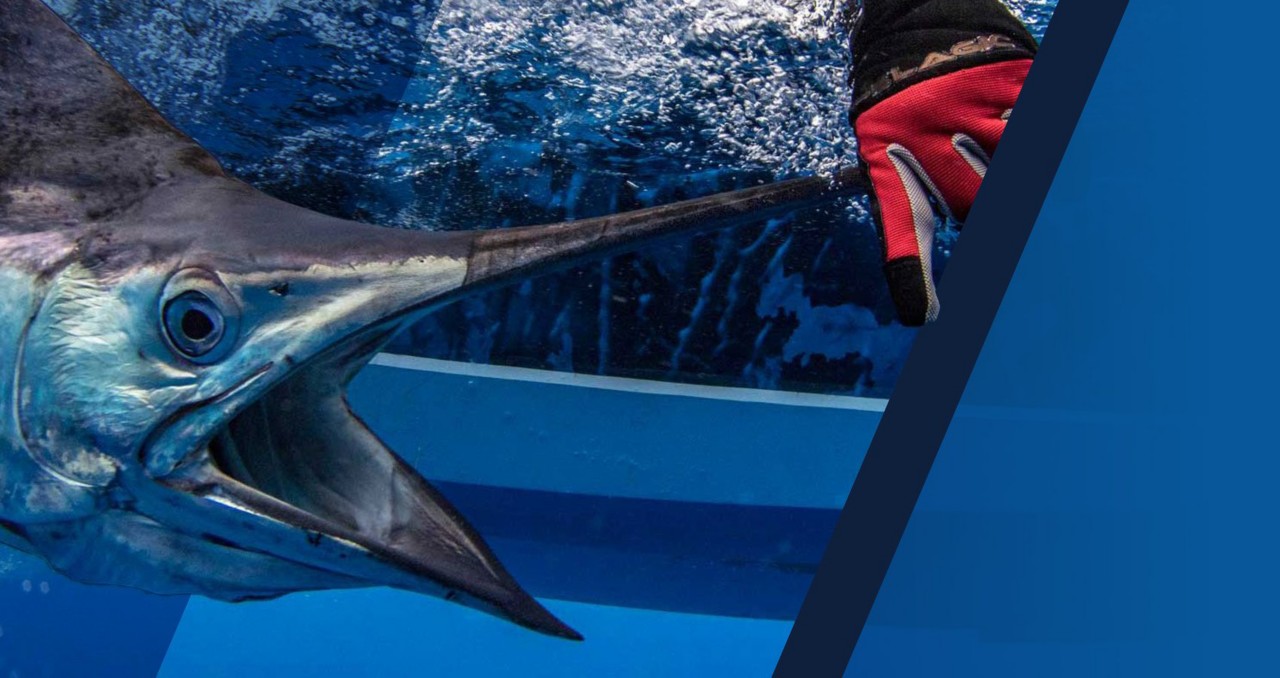A billfish exerts most – sometimes all – of its energy when fighting back against an angler, which is also the reason they are so acrobatic and fun to watch. However, if a billfish is pulled from the water, even for a short time, the lack of oxygen can be extremely harmful. Even if the fish seems to be healthy boat-side, it could die within a few hours or days after release.
In 2015, research showed that 86% of billfish caught in recreational fisheries survive the catch-and-release process. That means 14% of the billfish caught do not survive. With billfish populations continually declining globally, collective conservation efforts by all anglers who chase these amazing fish are highly needed.
Thankfully, a lot of time and effort have gone into studying billfish post-release behavior, leading to significant changes in both recreational and commercial billfish fishing. Dr. John Graves’ lab at Virginia Institute of Marine Science conducted studies on air exposure and the use of circle hooks, and how each affects billfish.
By studying white marlin, Dr. Graves’ lab found that billfish were 20 times more likely to die when caught using J-style hooks than when using circle hooks. The lab also found that when removing the billfish from the water, the likelihood of death increased to 29% compared to less than 2% when keeping the billfish in the water.
In the U.S., anglers are only allowed to remove a billfish from the water if they plan to keep it under the National Oceanic and Atmospheric Administration (NOAA) Highly Migratory Species (HMS) permit regulations. NOAA federal regulations state that Atlantic marlin and sailfish “must be released in a manner that will ensure maximum probability of survival, but without removing the fish from the water.”
Anglers worldwide can collectively do a better job at conserving billfish by properly handling fish after catching them. Below is a list of steps anglers can take to ensure a billfish swims away healthy. They were provided by the International Game Fish Association (IGFA), a nonprofit organization committed to the conservation of game fish and the promotion of responsible, ethical angling practices. These simple but essential steps go a long way in recovering a caught billfish.
- Use non-offset circle hooks. These hooks allow a clean removal from the corner of the mouth, which minimizes harm to the fish.
- Minimize rough handling. Remove the circle hook with a de-hooker. If not possible, cut the line at the hook.
- DO NOT remove the fish from the water. Keep the fish upright and its head below the water.
- If the fish is at all lethargic, take extra time to revive it. Hold the fish in the water while the boat is in motion so oxygen can flow through the fish’s gills. Wait until the fish has more energy and better color before releasing it.
Careful Handling Works
Ten years ago, the IGFA Great Marlin Race (IGMR) launched as a partnership with Dr. Barbara Block’s lab at Stanford University’s Hopkins Marine Station to study billfish behavior and ecology through satellite tagging. To date, more than 446 satellite tags have been deployed on seven species in 21 countries, logging nearly 240,000 nautical miles of billfish tracking and making the IGMR the world’s largest billfish tracking database.
Data from the IGMR has resulted in eight peer-reviewed publications and was also used to accomplish potentially the most crucial legislation to help protect billfish in U.S. conservation history, the Billfish Conservation Act of 2012 and a subsequent amendment in 2018.
In the early days of the IGMR program in 2011, IGFA President Jason Schratwieser was aboard a vessel in Puerto Rico when a large blue marlin was caught and brought in tail wrapped, colorless and nearly dead. The captain was sure the fish would die, but after working to revive the fish for nearly 15 minutes, it began regaining its color and showing signs of life. The crew decided to risk a $4,500 satellite tag on the fish, hoping it would indeed survive. Forty-six days later, the tag popped off the fish 419 nautical miles from where it was caught.
Reviving the fish had worked.
This success story proves that no matter how lethargic the billfish may be, anglers can dramatically decrease the possibility of post-release billfish mortality with the proper handling and care.
Enjoy chasing these beautiful fish and getting the picture of a lifetime, but make sure to follow the steps above so that the fish can swim away healthy, ready to fight another lucky angler.




